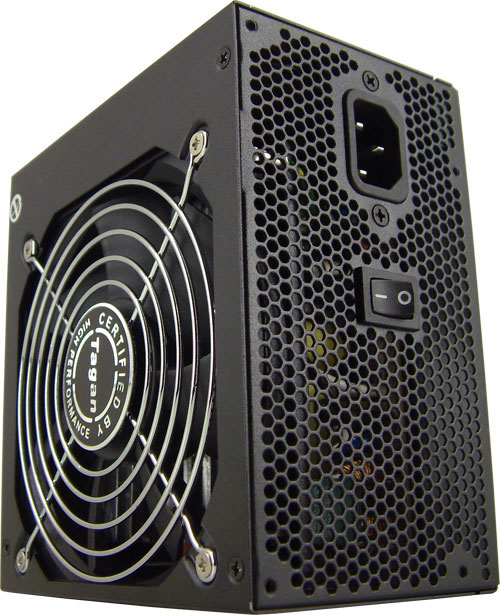500W to 550W: 12 Power Supplies Compared
by Christoph Katzer on February 20, 2009 5:00 AM EST- Posted in
- Cases/Cooling/PSUs
Tagan SuperRock TG500-U33II - Overview

The Tagan SuperRock 400W performed so well in our last roundup that we asked Maxpoint to send us a 500W model as well. We didn't bother to take new pictures, as the two power supplies are virtually identical in appearance with just some minor changes to a few components. This is another Enhance power supply like the Akasa and BFG units, but without the venting holes on the interior. Tagan also utilizes a 120mm fan instead of the 140mm fan we see on other Enhance units.

The internals of the SuperRock look empty, as there aren't all that many components. The primary section has the standard PFC and transient filtering and looks quite good. Nippon Chemi-Con provides the primary capacitor, with Teapo caps in the secondary.






















62 Comments
View All Comments
Christoph Katzer - Friday, February 20, 2009 - link
You can find the review herehttp://www.anandtech.com/casecoolingpsus/showdoc.a...">http://www.anandtech.com/casecoolingpsus/showdoc.a...
There are tons of others in the Cases/Cooling/PSUs section you might want to check out.
Nickel020 - Saturday, February 21, 2009 - link
There are reviews there, but it would be good if you could include PSUs you already reviewed in the conclusion to say how they measure up to the currently reviewed units.Most people just don't know enough about PSUs to judge how good that PSU in the single review is compared to the ones in the round-up.
kilkennycat - Friday, February 20, 2009 - link
No details on whether the SATA power connectors are right-angle or straight. For each power supply it would be very useful to detail the distribution of right-angle vs straight.. even to the extent of picturing or sketching the cables. In many of the mid-sized or uATX cases in which these power supplies might be used, the hard-disks may overhang the motherboard components or might bump into the rear of a video card. Remember that the SATA hard-disk power-port is much closer to the motherboard and its mounted components than the 4-pin Molex on PATA units. A right-angle SATA power connector might make all the difference between a comfortable fit and having to purchase a 4-pin Molex to right-angle SATA power adapter. I have run into this problem several times with computer cases where the hard-disks are mounted cross-wise and with little clearance between the rear of the hard-disk and the side-cover. Also my latest experience of this problem was on a recent uATX build that required 3-disk storage. The clearance space between one of the hard-disks and the motherboard memory DIMMS required a right-angle SATA power-connector. I had to satisfy that requirement with a 4-pin Molex to right-angle SATA power adapter.... If I had known in advance how many right-angle SATA power connectors came with the power-supply, I could have ordered the adapter in advance.....Christoph Katzer - Friday, February 20, 2009 - link
Quickly done, Akasa has the only angled SATA connectors and I Don't see that too often either...kilkennycat - Sunday, February 22, 2009 - link
Thanks for the reply.The Corsair HX520W Modular Power Supply has 2 modular SATA cables, each with one right-angle and one straight connector - a reasonable compromise.
Btw, the fact the Corsair HX520W was entirely missed from your 500-550W roundup is rather odd, with its high quality (HardOCP Review Gold Star, Dec 2007), 2-year-production quality history (now up to over 400 customer reviews on Newegg - 5 stars, uniquely unusual for a power-supply) It also has triple 18A max 12V outputs --- unlike those less expensive to manufacture with only one 12V rail and umpteem amps on that rail. The single-12V high-wattage power-supplies totally ignore Intel's SAFETY recommendation of a maximum of 20A per 12V output. An internal quasi-short - dendrite growth, fine metallic bits, loose wire-clippings etc - involving the 12V rail and with one of these 40-50amp 12V current power-supplies can potentially turn your PC instantly into a very handy radiant heater/fire-source.
strikeback03 - Monday, February 23, 2009 - link
Are you talking about this roundup? The Corsair is in there.kilkennycat - Tuesday, February 24, 2009 - link
Oops !!! MANY APOLOGIES to both you and Christopher. I was speed-reading the Introductory page and read the following :- "We have four units manufactured by Enhance, four more from Seasonic, two by Sirtec, one Enermax, and one Topower. " I did not realize that Christopher was referring there to the original power-supply OEMs and not the retail labels. It would have been nice to have a list of the actual retail model numbers of the 12 power-supplies on the intro page. As it was, I only read the first few reviews and quit before I got down as far as the Corsair..... Again, many apologies. Long day, late night reading, insufficient reading stamina....Nickel020 - Friday, February 20, 2009 - link
First off, great job on the performance review part! The graphs are great and much easier to understand than the usual screenshots from the measuring software.I'm a little disappointed by the acoustics part though. dB measuremeents are pretty much useless since they don't really reflect subjective sound perception. PSUs with "more" dBs will often be considered quieter, in fact, dB measurements don't reflect the ranking of PSUs that you will find on silentpcreview.com
Measurements in Sone would be much better, but I guess the testing equipment is somewhat expensive :(
Since you're also from Germany, wouldn't some kind of cooperation with PCGH or even c't be possible?
Something else that I'm missing here is a Be Quiet! unit, but I think they're pretty similar to the Tagans, are they not?
That's all :)
Thanks again for the article!
Nickel020 - Saturday, February 21, 2009 - link
One more comment:What happened to the fan speed/load curves?
Those were really useful fo judging acoustics. If you know the fan that was used in there then you can judge the subjective noise at a certain RPM pretty well.
philosofool - Friday, February 20, 2009 - link
I bookmarked this article because I want to have it around next time I'm shopping for computer parts. Unlike processors and similar components, where every extra dollar spent usually comes with a little more perforamnce, PSUs are an area where price and quality come apart. I want a stable, cool, QUIET PSU, and I want to pay as little as possible to have that. Every dollar I save getting a PSU that will do just what I need is another dollar I can spend on a video card. This article is going to help me build a better machine.